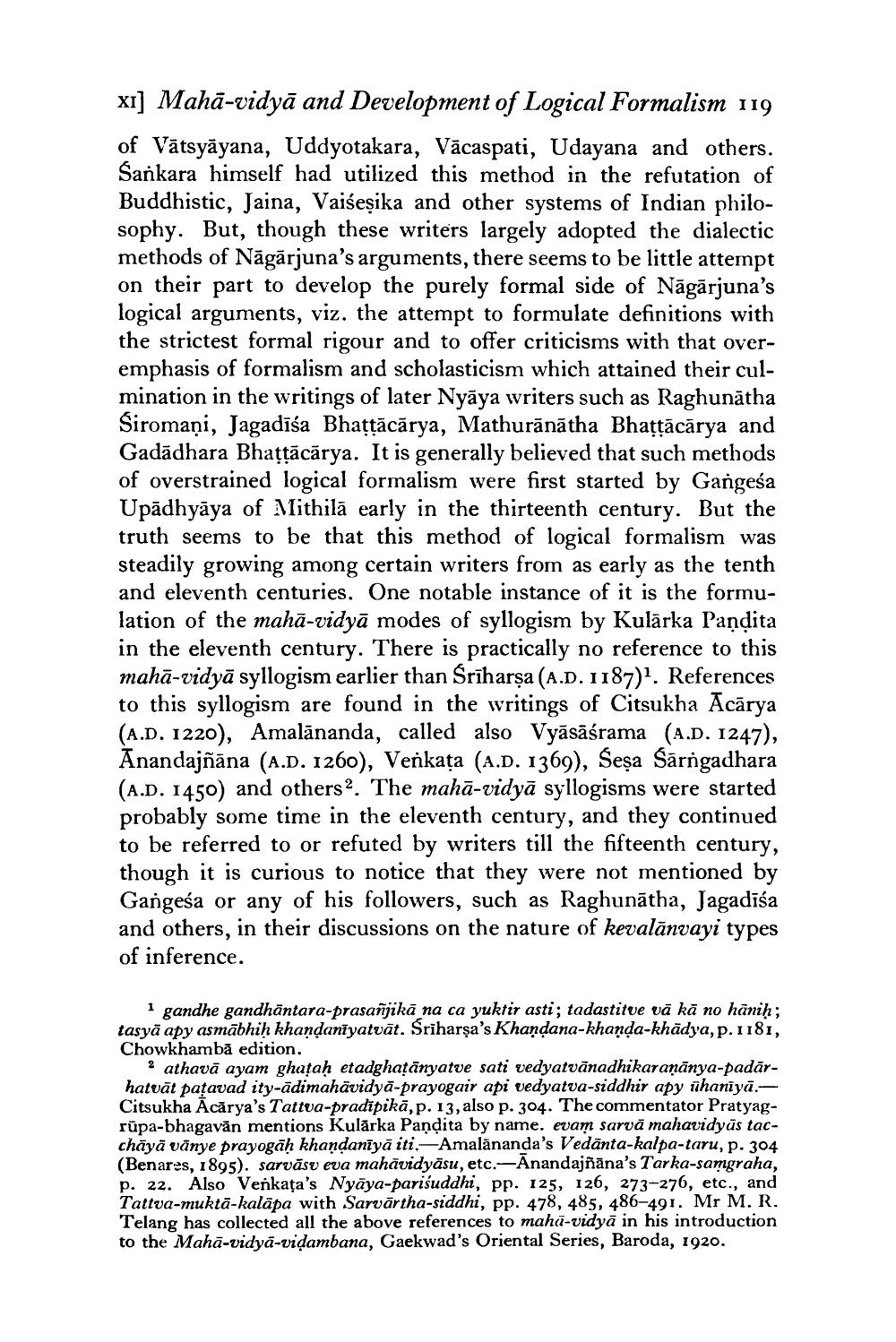________________
XI] Mahā-vidyā and Development of Logical Formalism 119 of Vātsyāyana, Uddyotakara, Vācaspati, Udayana and others. Sankara himself had utilized this method in the refutation of Buddhistic, Jaina, Vaiseșika and other systems of Indian philosophy. But, though these writers largely adopted the dialectic methods of Nāgārjuna's arguments, there seems to be little attempt on their part to develop the purely formal side of Nāgārjuna's logical arguments, viz. the attempt to formulate definitions with the strictest formal rigour and to offer criticisms with that overemphasis of formalism and scholasticism which attained their culmination in the writings of later Nyāya writers such as Raghunātha Siromaņi, Jagadīša Bhattācārya, Mathurānātha Bhattācārya and Gadādhara Bhattācārya. It is generally believed that such methods of overstrained logical formalism were first started by Gangesa Upādhyāya of Mithilā early in the thirteenth century. But the truth seems to be that this method of logical formalism was steadily growing among certain writers from as early as the tenth and eleventh centuries. One notable instance of it is the formulation of the mahā-vidyā modes of syllogism by Kulārka Pandita in the eleventh century. There is practically no reference to this mahā-vidyā syllogism earlier than Śrīharsa (A.D. 1187). References to this syllogism are found in the writings of Citsukha Ācārya (A.D. 1220), Amalānanda, called also Vyāsāśrama (A.D. 1247), Anandajñāna (A.D. 1260), Verkata (A.D. 1369), Seșa Sārngadhara (A.D. 1450) and others. The mahā-vidyā syllogisms were started probably some time in the eleventh century, and they continued to be referred to or refuted by writers till the fifteenth century, though it is curious to notice that they were not mentioned by Gangeśa or any of his followers, such as Raghunātha, Jagadīša and others, in their discussions on the nature of kevalānvayi types of inference.
1 gandhe gandhāntara-prasanjikā na ca yuktir asti; tadastitve vā kā no hānih; tasyā apy asmābhiḥ khandanīyatvāt. Sriharşa's Khandana-khanda-khādya, p. 1181,
na wakhambā edition. ndaniyatvãt. Sriharsyuktir asti; tadast
? athavā ayam ghataḥ etadghatānyatve sati vedyatvānadhikaraṇānya-padārhatvāt patavad ity-ādimahāvidyā-prayogair api vedyatva-siddhir apy ühanīyā.Citsukha Ācārya's Tattua-pradipikā,p. 13, also p. 304. The commentator Pratyagrüpa-bhagavān mentions Kulárka Pandita by name, evam sarvā mahavidyās tacchāyā vānye prayogāh khandanīyā iti.-Amalānanda's Vedānta-kalpa-taru, p. 304 (Benares, 1895). sarvāsu eva mahāvidyāsu, etc.-Anandajñāna's Tarka-samgraha, p. 22. Also Venkata's Nyāya-parisuddhi, pp. 125, 126, 273-276, etc., and Tattva-muktā-kalāpa with Sarvārtha-siddhi, pp. 478, 485, 486-491. Mr M. R. Telang has collected all the above references to mahu-vidyā in his introduction to the Mahā-vidya-vidambana, Gaekwad's Oriental Series, Baroda, 1920.




